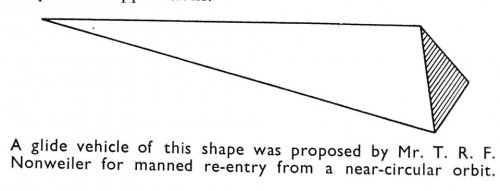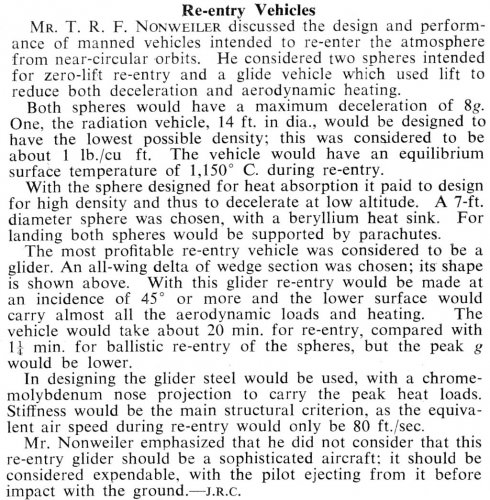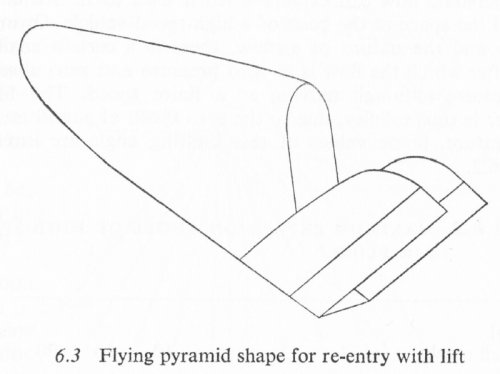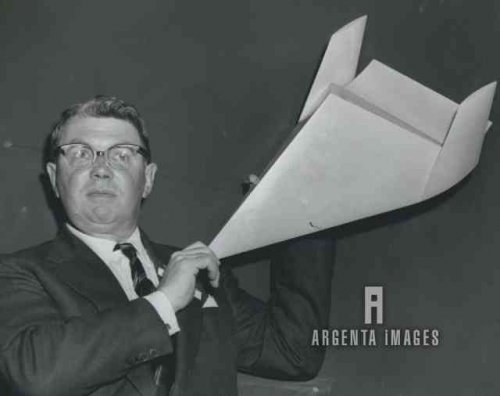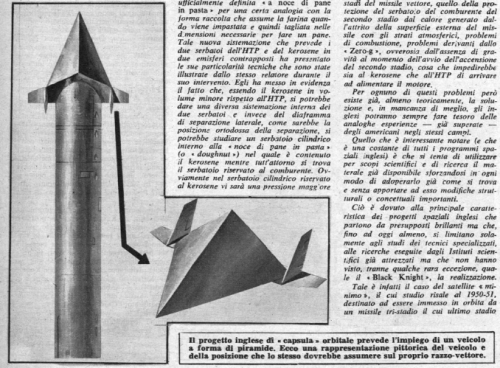You are using an out of date browser. It may not display this or other websites correctly.
You should upgrade or use an alternative browser.
You should upgrade or use an alternative browser.
Armstrong-Whitworth Pyramid and new launch vehicle
- Thread starter PMN1
- Start date
- Joined
- 13 August 2007
- Messages
- 8,445
- Reaction score
- 10,996
Barrington Bond said:
THX for info Barrington Bond
that mechanical display is soooo cute
archipeppe
ACCESS: Top Secret
- Joined
- 18 October 2007
- Messages
- 2,431
- Reaction score
- 3,152
Thanks Barry.
It seems that the Pyramid was, at least, the most serious UK try to get space access, in terms of R&D and testing phase.
As far you know, any full scale mock-up was built (or forseen) for such spacecraft?
We had seen, in another topic, what looked alike a full scale capsule mock-up so it would be interesting to know if Pyramid had the same chance...
It seems that the Pyramid was, at least, the most serious UK try to get space access, in terms of R&D and testing phase.
As far you know, any full scale mock-up was built (or forseen) for such spacecraft?
We had seen, in another topic, what looked alike a full scale capsule mock-up so it would be interesting to know if Pyramid had the same chance...
I have no idea about any mockups - but until I saw that footage I had no idea about that!
Regards,
Barry
Regards,
Barry
Hi Barry,
Our Hero! Fantastic find. Remember this work was de-classified in 1959, released for the BIS London Commonwealth Space Conference, August 1959 when the UK military programme was still active. The work was still evolving then, Roy Dommet states that there was an earlier AW submission for a three man vehicle and we know there was much more refined AW version by then which I think there was illustration posted some time ago?
I guess in 1959 the classified work was progressing or maybe another company got the job? There is still an open question, but thanks again, what a super find.
Our Hero! Fantastic find. Remember this work was de-classified in 1959, released for the BIS London Commonwealth Space Conference, August 1959 when the UK military programme was still active. The work was still evolving then, Roy Dommet states that there was an earlier AW submission for a three man vehicle and we know there was much more refined AW version by then which I think there was illustration posted some time ago?
I guess in 1959 the classified work was progressing or maybe another company got the job? There is still an open question, but thanks again, what a super find.
Barrington Bond said:I have no idea about any mockups - but until I saw that footage I had no idea about that!
Regards,
Barry
- Joined
- 22 April 2012
- Messages
- 2,258
- Reaction score
- 2,306
According to "Aeroplane and commercial aviation news", Volume 98 Armstrong Whitworth had a small team working on this for at least 3 years, though how much they were working on it is unclear, supposedly a Blue Streak/Black Knight combination would have been able to lift a half scale model.
From “Astronautics at Armstrong Whitworth’s” by HR Hilton
In reference to diagrams “but to obtain good definition, all edges and the nose of the vehicle are shown completely sharp. Optimum resistance to heating effects would, of course, require a blunted nose and substantial edge radii.”
Trailing edge control design.
Wing area – 332 sq ft
Wing structure weight at 5 lb/sq ft = 1,660 lb
Fins 140 lb
Capsule, including 2 pilots, instruments, etc. 2,000 lb
Retro rockets, fuel and tanks. 200 lb
Control actuator, power supplies, etc. 120 lb
= 4,120 lb
Wing loading – 12.4 lb/sq ft
Theoretical AW design for booster.
100 ft tall (ref RAF Flying Review 1959) Total weight 160 tons
First stage 133.5 tons. Of which 120 tons is oxidiser and fuel.
41 ft long 13 ft diameter.
Fully gimballed motor unit – sea level thrust of 450,00 lb.
Propellant specific impulse of 270 lb/sec mass ratio of 4.0
Height and spedd of burn out 40 miles and 9,700 ft/sec at 40 degree to the horizontal
Burning time 161 sec.
Image stage jettisoned.
Second stage 22.07 tons of which 19.85 tons of propellants same as first stage.
Gimballed motor of 69,400 lb thrust for 173 sec.
To height of 75 miles speed 21,000 ft/sec 3 degrees.
Coasting for several minutes to above 80 miles while ground computers take readings and calculate third stage burn time.
Third stage gimballed motor thrust of 30,000 lb same “species” of propellants.
Speed 26,640 ft/sec at burn out.
In reference to diagrams “but to obtain good definition, all edges and the nose of the vehicle are shown completely sharp. Optimum resistance to heating effects would, of course, require a blunted nose and substantial edge radii.”
Trailing edge control design.
Wing area – 332 sq ft
Wing structure weight at 5 lb/sq ft = 1,660 lb
Fins 140 lb
Capsule, including 2 pilots, instruments, etc. 2,000 lb
Retro rockets, fuel and tanks. 200 lb
Control actuator, power supplies, etc. 120 lb
= 4,120 lb
Wing loading – 12.4 lb/sq ft
Theoretical AW design for booster.
100 ft tall (ref RAF Flying Review 1959) Total weight 160 tons
First stage 133.5 tons. Of which 120 tons is oxidiser and fuel.
41 ft long 13 ft diameter.
Fully gimballed motor unit – sea level thrust of 450,00 lb.
Propellant specific impulse of 270 lb/sec mass ratio of 4.0
Height and spedd of burn out 40 miles and 9,700 ft/sec at 40 degree to the horizontal
Burning time 161 sec.
Image stage jettisoned.
Second stage 22.07 tons of which 19.85 tons of propellants same as first stage.
Gimballed motor of 69,400 lb thrust for 173 sec.
To height of 75 miles speed 21,000 ft/sec 3 degrees.
Coasting for several minutes to above 80 miles while ground computers take readings and calculate third stage burn time.
Third stage gimballed motor thrust of 30,000 lb same “species” of propellants.
Speed 26,640 ft/sec at burn out.
Quindar Beep
"I really hope they fix that"
I just came across the following contemporary reports from the first public discussions of the Pyramid 1959 British Commonwealth Space Flight Symposium:
"British Plan Delta-Wing Space Ship for Two Men", Palm Beach Post, Aug. 28 1959.
"Pyramid-Shaped Vehicle for Safe Return", Glasgow Herald, Aug. 28, 1959.
EDIT: (thanks to Barrington for the clarification) What's a bit confusing is that the first article clearly says it's Hawker Siddeley working on this, not Armstrong Whitworth, despite it clearly being called "Pyramid"--see Barrington's post below for the reason.
"British Plan Delta-Wing Space Ship for Two Men", Palm Beach Post, Aug. 28 1959.
"Pyramid-Shaped Vehicle for Safe Return", Glasgow Herald, Aug. 28, 1959.
EDIT: (thanks to Barrington for the clarification) What's a bit confusing is that the first article clearly says it's Hawker Siddeley working on this, not Armstrong Whitworth, despite it clearly being called "Pyramid"--see Barrington's post below for the reason.
Quindar Beep
"I really hope they fix that"
Barrington Bond said:Armstrong Whitworth were part of the Hawker Siddeley Group of companies. - it says so in the 2nd link.
That's that sorted then. Surprisingly many secondary sources on this seem to think that the Armstrong Whitworth Pyramid and the Hawker Siddeley Waverider are two different things, which was where I was starting myself when I ran across the first article.
- Joined
- 13 August 2007
- Messages
- 8,445
- Reaction score
- 10,996
Nice find, Barrington
- Joined
- 13 August 2007
- Messages
- 8,445
- Reaction score
- 10,996
Opening of the Commonwealth Spaceflight Symposium - World Astronautical Week - in London. Organised by the British Interplanetary Society - the Commonwealth Spaceflight Symposium and World Astronautical Week opened this morning at Church House, Westminster... Many persons - famous in the field of space travel research are to lecture on its many aspects. Keystone Photo Shows: Dr. W.P. Hilton who is one of the world's leading aerodynamicists - explains the function of a new Pyramid type space ship which is expected to be used in the future... It is said that this type would travel at about 18,000 mph and return its occupants safely to earth... He is using a model of the "Pyramid" satellite. Seen at the meeting this morning.
Source:
https://www.argentaimages.com/media/image/q/modeling/page/130
Attachments
zebedee
ACCESS: Secret
Found this on display in the Midland Air Museum last week...

Armstrong Whitworth 'Pyramid' re-entry vehicle from the 60's by InfinitePlanes, on Flickr
Zeb
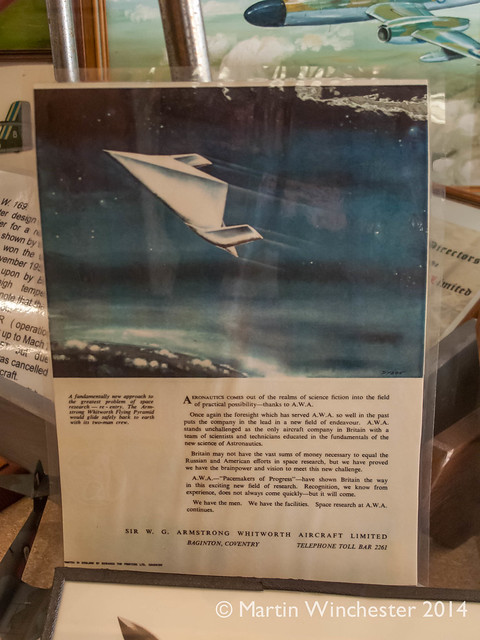
Armstrong Whitworth 'Pyramid' re-entry vehicle from the 60's by InfinitePlanes, on Flickr
Zeb
- Joined
- 19 October 2012
- Messages
- 1,982
- Reaction score
- 1,936
Yes, there really was only the one project and that was only carried as far as basic concept
- Joined
- 26 May 2006
- Messages
- 34,894
- Reaction score
- 15,758
Schneiderman said:Yes, there really was only the one project and that was only carried as far as basic concept
Thank you my dear Schneiderman.
- Joined
- 9 October 2009
- Messages
- 21,969
- Reaction score
- 13,616
They seem to have added a small model of one of the design variants in the years since.Found this on display in the Midland Air Museum last week...
View: https://www.reddit.com/r/WeirdWings/comments/18tl5no/armstrong_whitworth_aircraft_pyramid/
Via that post's comments:

The Armstrong Whitworth Pyramid: For an Empire on the Up
What it was: A proposal put forward in 1959 by Armstrong Whitworth, a British aircraft manufacturer, to build a pyramidal spaceplane to put on top of a two-stage rocket composed of a Black Knight r…
The AW. Pyramid at MAM. is 72 scale model by Sid Ellerington built from Spot On Resin kit (still avaliable) 

 www.facebook.com
www.facebook.com

Spot On Designs
Spot On Designs. 371 likes · 2 talking about this. Spot On Designs produces 1/72 scale resin and vacuform models and accessories for the hobby enthusiast
 www.facebook.com
www.facebook.com

